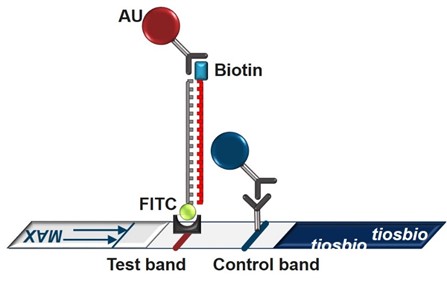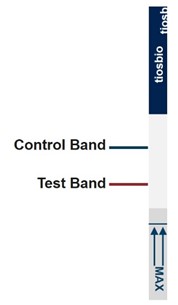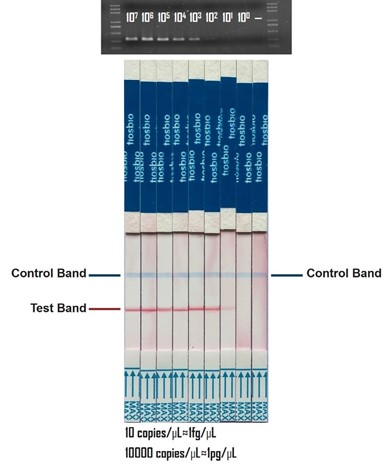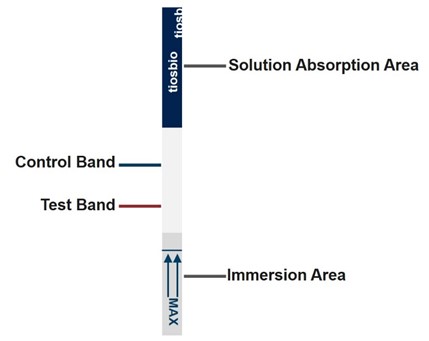- 宝盈同汇网站产品目录更新中
- 131 2661 6699
- 187 0140 6699
- biowinner@163.com
Information
Warnings and Precautions
The strips should be stored at room temperature (18~28℃) in their original containers.
The expiration date of all components must be observed.
Protect strips from humidity; Container must always be closed.
After unpacking, unused strips need to be put in ziplock bags. If left for a long time after unpacking, please use after drying in oven at room temperature (18~28℃) for 8 hours.
Touch only the logo-covered areas of the strips.
The disposal of waste materials must be carried out according to current local regulations.
For professional users.
Intended Use
LF-detect is a universal lateral flow strip for the detection of analytes (proteins, amplification product) labelled with FITC and biotin. It is a development platform. The test is for research use only, not for diagnostic purposes.
Materials Required (not included)
Pipets
Pipet tips (containing protective filters for PCR)
Reaction tubes or 96-well microtiter plate
Necessary Development Work -Development Platform
Development of a solution, containing two different labeled detectors for the analyte.
Following conditions are necessary:
1) Detectors must be labeled with:
FITC (fluorescein isothiocyanate)
Biotin
2) Use about 25-50 μL fluid (sample material and analyte-specific solution) for the assay procedure.
Notice:
Volumes, analyte-specific solution, and detect conditions are part of the individual test development.
A basic procedure for the detection of genomic amplicons is explained on page 3: “Assay performance “PCR-products””. The amplification product should be biotinylated and the specific hybridization probe should be FITC labeled. In principle all amplification procedures (Polymerase Chain Reaction or isothermal amplifications like LAMP or RPA) can be used.
Method
Tiosbio® LF-detect is a ready-to-use, universal test strip (dipstick), which is based on the lateral flow technology using gold particles. The strip is designed to develop rapid test systems for several analytes such as proteins, antibodies, or gene amplificons. The user needs to develop an analyte-specific solution, which contains a first detector (e.g. antibody, antigen, specific probe) labeled with FITC and a second one (e.g. antibody, primer) labeled with biotin.
The strip should be placed directly into the sample solution.
No assay buffer required.
The complexed analyte, labeled with FITC and biotin, binds first to the gold-labeled Biotin-specific antibodies in the sample application area of the dipstick. The gold complexes travel through the membrane, driven by capillary forces. Only the analyte captured gold particles will bind when they pass the line with the immobilized biotin-ligand molecules and generate red band (Test band) or blue band (Control band) over the time. Unbound gold particles migrate over the control band and will be captured by species-specific antibodies. With prolonged incubation time, the formation of an intensely colored control band appears.


Control Band strip
In any case, the control band must be visible!
The Control band is blue.
It is a control function and can not be used to assess the quality of the result of the test band. If the control band is not visible after the incubation period, the result is invalid! The test must be repeated with a new dipstick!
Interpretation of Results
Tiosbio® LF-detect strip results:

Assay Performance “PCR-Products”

1. Take the required number of dipsticks out of the container and mark them at back.
2. Place the strips with the sample immersion area into the solution directly and incubate them e. g. for 5~15 minutes in an upright position.
3. In the end of incubation period, remove dipsticks from assay solution and interpret test results immediately.
Notice:
If a higher analytical sensitivity is required, it could be helpful to increase the volume of the PCR amplification template.
Volumes, the volume of the PCR amplification template, and incubation time are always part of the individual test development.
Interpretation of “PCR” Results
|
The PCR amplicon was detected (positive). |  |
 |
 |
|
| 2. Only control band is visible as red line. | No PCR amplicon was detected (negative). |
positive | negative | not valid |
Important note:
To check specificity of the reaction the introduction of a PCR negative control is strongly recommended.
Trouble Shooting “PCR”
| Problem | Possible cause(s) | Recommendation |
| Control band is not visible. | a) wrong or degraded assay buffer b) expiration date of dipsticks is exceeded c) wrong storage conditions of dipsticks |
apply new (fresh) chemicals |
| Negative result with dipstick but clearly visible band in agarose gel | a) detection of an unspecific PCR product in agarose gel b) hybridization was not successful |
Check identity of PCR product by Southern blotting oder sequence analysis Check conditions of hybridization. |
| Mineral oil | a) mineral oil affects flow characteristics of the assay b) development of test band might be hampered. |
Remove PCR product very slowly from the bottom of the reaction vial. |
Assay Sensitivity “PCR”
Analytical sensitivity of the Tiosbio®
LF-detect is equivalent or up to 100 fold higher than a Ethidium Bromide stained agarose gel. Dependent on the size of the PCR product and the number of amplification cycles up to 1 fg/μL DNA can be detected.
Materials Supplied, Storage and Stability
| Components* | Content | Preparation | Storage | Shelf Life |
| LF-detect strips | 50 tests | Ready-to use | room temperature (18~28℃) ;Direct-detect must be protected from moisture! | until expiry date |
*No assay buffer required.
本页所列之化学品技术说明书系宝盈公司版权所有, 对于此地所阐明的信息或与该信息相关之产品,不承诺任何明示或暗示的担保。
本页所列之技术说明书有版权保护,未经允许禁止转载。
本网站上的信息可能包含技术错误或印刷错误。资料可能随时更改或更新而不另行通知。
可能随时改进和/或更改产品和/或本资料中描述的任何项目,恕不另行通知。
Warnings and Precautions
The strips should be stored at room temperature (18~28℃) in their original containers.
The expiration date of all components must be observed.
Protect strips from humidity; Container must always be closed.
After unpacking, unused strips need to be put in ziplock bags. If left for a long time after unpacking, please use after drying in oven at room temperature (18~28℃) for 8 hours.
Touch only the logo-covered areas of the strips.
The disposal of waste materials must be carried out according to current local regulations.
For professional users.
Intended Use
LF-detect is a universal lateral flow strip for the detection of analytes (proteins, amplification product) labelled with FITC and biotin. It is a development platform. The test is for research use only, not for diagnostic purposes.
Materials Supplied, Storage and Stability
| Components* | Content | Preparation | Storage | Shelf Life |
|
LF-detect strips |
50 tests |
Ready-to use |
room temperature (18~28℃) ;Direct-detect must be protected from moisture! |
until expiry date |
*No assay buffer required.
Materials Required (not included)
Pipets
Pipet tips (containing protective filters for PCR)
Reaction tubes or 96-well microtiter plate
Necessary Development Work -Development Platform
Development of a solution, containing two different labeled detectors for the analyte.
Following conditions are necessary:
1) Detectors must be labeled with:
FITC (fluorescein isothiocyanate)
Biotin
2) Use about 25-50 μL fluid (sample material and analyte-specific solution) for the assay procedure.
Notice:
Volumes, analyte-specific solution, and detect conditions are part of the individual test development.
A basic procedure for the detection of genomic amplicons is explained on page 3: “Assay performance “PCR-products””. The amplification product should be biotinylated and the specific hybridization probe should be FITC labeled. In principle all amplification procedures (Polymerase Chain Reaction or isothermal amplifications like LAMP or RPA) can be used.
Method
Tiosbio® LF-detect is a ready-to-use, universal test strip (dipstick), which is based on the lateral flow technology using gold particles. The strip is designed to develop rapid test systems for several analytes such as proteins, antibodies, or gene amplificons. The user needs to develop an analyte-specific solution, which contains a first detector (e.g. antibody, antigen, specific probe) labeled with FITC and a second one (e.g. antibody, primer) labeled with biotin.
The strip should be placed directly into the sample solution.
No assay buffer required.
The complexed analyte, labeled with FITC and biotin, binds first to the gold-labeled Biotin-specific antibodies in the sample application area of the dipstick. The gold complexes travel through the membrane, driven by capillary forces. Only the analyte captured gold particles will bind when they pass the line with the immobilized biotin-ligand molecules and generate red band (Test band) or blue band (Control band) over the time. Unbound gold particles migrate over the control band and will be captured by species-specific antibodies. With prolonged incubation time, the formation of an intensely colored control band appears.


Control Band strip
In any case, the control band must be visible!
The Control band is blue.
It is a control function and can not be used to assess the quality of the result of the test band. If the control band is not visible after the incubation period, the result is invalid! The test must be repeated with a new dipstick!
Interpretation of Results
Tiosbio® LF-detect strip results:

Assay Performance “PCR-Products”

1. Take the required number of dipsticks out of the container and mark them at back.
2. Place the strips with the sample immersion area into the solution directly and incubate them e. g. for 5~15 minutes in an upright position.
3. In the end of incubation period, remove dipsticks from assay solution and interpret test results immediately.
Notice:
If a higher analytical sensitivity is required, it could be helpful to increase the volume of the PCR amplification template.
Volumes, the volume of the PCR amplification template, and incubation time are always part of the individual test development.
Interpretation of “PCR” Results
|
The PCR amplicon was detected (positive). |  |
 |
 |
|
| 2. Only control band is visible as red line. | No PCR amplicon was detected (negative). |
positive | negative | not valid |
Important note:
To check specificity of the reaction the introduction of a PCR negative control is strongly recommended.
Trouble Shooting “PCR”
| Problem | Possible cause(s) | Recommendation |
| Control band is not visible. | a) wrong or degraded assay buffer b) expiration date of dipsticks is exceeded c) wrong storage conditions of dipsticks |
apply new (fresh) chemicals |
| Negative result with dipstick but clearly visible band in agarose gel | a) detection of an unspecific PCR product in agarose gel b) hybridization was not successful |
Check identity of PCR product by Southern blotting oder sequence analysis Check conditions of hybridization. |
| Mineral oil | a) mineral oil affects flow characteristics of the assay b) development of test band might be hampered. |
Remove PCR product very slowly from the bottom of the reaction vial. |
Assay Sensitivity “PCR”
Analytical sensitivity of the Tiosbio®
LF-detect is equivalent or up to 100 fold higher than a Ethidium Bromide stained agarose gel. Dependent on the size of the PCR product and the number of amplification cycles up to 1 fg/μL DNA can be detected.

